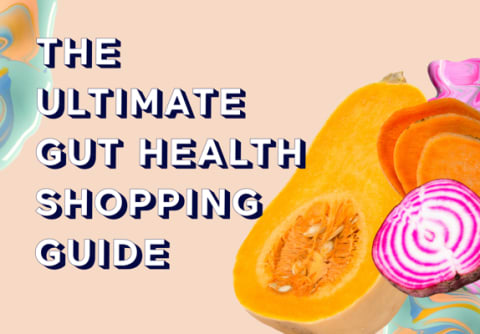Advertisement
Fermenting Is The Easiest, Cheapest Way To Heal Your Gut Daily. Here's The Beginner's Guide


Fermentation used to be as common in cooking as a sauté or a boil. In the United States, the fermentation flow stopped when the new wave of TV dinners and spreadable butters became the norm. It's a shame because our culturally connected ancestors were really onto something with their buckets of sauerkraut. While the smell can be a bit off-putting, the mind-body benefits are worth every sniff.
The modern American lifestyle includes seasonal rounds of antibiotics, pasteurized dairy, and sanitized produce. This combination kills off the beneficial bacteria necessary for a thriving gut.
Incorporating fermented foods back into our diets can improve the function of almost every system in the body. Here's a breakdown of their most essential benefits.
Help gut flora.
Ingesting these happy microbes creates an ecosystem of supportive microbiota in your GI system. These friendly bacteria live primarily in our large intestine and help overpower illness-causing microbial invaders.
Support the endocrine system.
The GI tract is the largest endocrine organ in the body, controlling emotion, metabolism, and immune response. While the thyroid has had its moment in the endocrine spotlight, the GI system has more than triple1 the mood-stabilizing, weight-management, and cold-fighting control.
Aid digestion.
Help with nutrient absorption.
With the help of ferments, your digested nutrients are transformed into their most bioavailable form1. Bioavailable nutrients are quickly and easily used by the body for all of its many functions. Calcium bioavailability is greatly enhanced with the presence of acid from the lactobacillus bacteria found in ferments, a hugely important micronutrient for young women to maintain healthy bone density.
Make your skin glow.
The process of fermentation also synthesizes beauty-boosting nutrients3 including vitamin B12, folic acid, and biotin for shiny hair and glowing skin.
Thinking you might want to try out this practice for yourself? Home fermenting is super cheap and relatively easy with a touch of patience. The easiest way to reap this long list of benefits is to simply make fermented foods and eat a little every day.

How to ferment just about anything:
1. Find organic produce.
Non-organic produce is sprayed with pesticides, and the good bacteria is killed off before it even makes it onto the shelf. Bonus points for local, seasonal, farmers market produce with bacteria that are most complementary to your physical surroundings and can improve seasonal allergies and reduce the likelihood of getting the common cold. I love using heartier veggies like cabbage, carrots, beets, and celery that will maintain their crunch after the fermentation process.
2. Find a vessel.
I like to use Mason jars of varying sizes for my mad scientist veggie projects. In my opinion, specialized "fermentation jars" are overpriced and unnecessary. Wash your jars with water and soap and set them aside to air dry. If you're worried about the cleanliness of your jars, feel free to rinse them with an apple cider vinegar and water solution.
3. Find a trusty bacterial starter.
I have been using the same starter for almost four years now; I got it from an amazing fermentation workshop, and it’s been my ride-or-die ever since. Having a trusty starter is important because it needs to contain strong, good bacterial strains that will fight off dangerous bacteria like E. coli. If you can find a friend with a good starter, that's ideal, but you can also procure a powdered starter online or at a health food store. Another option is to sign up for a workshop (I often host these in LA) like I did to get a trusty starter from an expert.
4. Stuff the jars with veggies, seasoning, starter, and cover with filtered water.
The process of your bacterial starter fermenting the veggies takes about a week or two depending on how intense you want the flavor to be. I always suggest storing ferments in a dark, cool place to prevent the bacteria from working at hyperspeed and causing an effervescent explosion. Another important tip is to only open fresh jars of ferments carefully over the sink to prevent an unwanted bacterial shower. After you achieve your desired puckering taste, move your ferments into the fridge, where they will last about eight months.
How much fermented foods should you actually eat?
Now that you’ve got kraut coming out of your ears, knowing how much to eat is quite essential. Starting out small is the best way to introduce fermented foods into your diet. Every human microbiome is different, and each person's reaction to ferments can vary. Eating too much fermented food in one sitting can wreak havoc on your digestive system. It's best to start with a tablespoon or two every day for about a week and slowly increase depending on your reaction. Eating a tablespoon a day is more than enough to reap all of the benefits. Personally, I can eat about half a jar of fermented foods with no issues, but that’s after years of building up my tolerance.
If you're busy and can't make your own fermented foods, you can buy probiotics in dry capsule form— just choose wisely. The bottle should say "survivability-certified," ensuring your pill survives harsh stomach conditions. You also want to find a probiotic supplement that is transparent about what bacterial strains are included. Other options include buying fermented veggies or kombucha—just make sure the packaging says "Live," as dead bacteria are far less helpful.
This guy ate ONLY fermented food for a year. Here's what happened.
